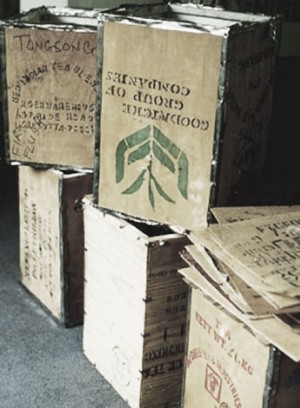Grandpa Joe Up-cycles a Tea Chest
My Grandfather worked as a furniture salesman in the early part of the last century. As well as selling contract furniture, he enjoyed attending auctions and finding furniture that he could adapt or repurpose. Ever resourceful and talented, he managed to outfit his home with items that he rebuilt or repaired. He made several lovely pieces from salvaged wood. There were spinet desks made from rescued cherry wood, a cedar-lined chest made for my Mother’s trousseau and a doctor’s swivel chair among dozens of other treasures. When I was a child, we visited him often in Collingwood, Ontario. We slept in “Treetops”, a flat above his workshop with a misty view of Blue Mountain. His large market garden separated Treetops from his main Panabode-style cedar cottage, which in later years he painted aluminum (yes, he was an eccentric). Treetops was the ultimate in “up-cycling” – a cottage moved from Wasaga Beach and reconstructed on his property. There was electricity but no plumbing. It was an odd mix of opulent (velvet settees and satin duvets) and rustic (chamber pots and water from the garden pump).
On the upper porch where we enjoyed fresh Golden Bantam corn from his garden, we sat on bentwood café chairs. They were upholstered in velvet or whatever remnant he had on hand. After I inherited them, I removed the old cloth and stuffing to discover plywood seats, one of them with a distinctively tea-related message.



British Assam Tea
It is clear that the tea leaves that arrived in this chest hailed from British Assam and reached Canada via London. I will hazard a guess that my Grandfather’s repair was done between 1920 – 1935 when his household was lively with family and visitors.


Tea production in the north of India was in full play in the 1920’s and 30’s and pre-war there were no impediments to shipping through the Suez Canal. The Assam tea bush grows in a lowland region, in the valley of the Brahmaputra River. Assam tea is made from the Camellia Sinensis assamica var., a large leaf varietal which thrives in Assam’s tropical weather. In the early part of the 19th century tea was cultivated experimentally in the north of India although most tea imports in England were still coming from China. The East India Company used it’s questionable authority and private military to grab large tracts of land in the low lying valley. When the EIC eventually lost command of the area through an act of parliament (mid- 1800’s), English gentry were encouraged to come to India and take on a tea garden.
Café Chair No. 14

The Thonet (pronounced with a hard T and rhyming with bonnet) Café Chair No. 14 (see video) was a popular commercial chair, designed by German cabinet maker Michael Thonet (1796 – 1871). This chair won the gold medal at the 1867 World’s Fair competition in Paris. The Café Chair No. 14 was produced in large numbers (50 million) throughout the late 19th and early decades of the 20th Century. It revolutionized furniture production as it was shipped in knock down version. The components could be easily packed for delivery to North America where the chairs were assembled once they reached their destination. Some of the seats were caned (a form of weaving with rattan) and some styles have plywood veneer seats or were upholstered. I have 4 of these chairs in good repair and another in need of a new seat. I love the simplicity of their graceful lines which belie their durability. Mine are not marked or labelled, so they may be knock offs, but they are probably over a century old.
I will be upholstering the chairs soon and it gladdens me to think that decades from now someone will remove the covering and find the piece of tea chest. Perhaps, just perhaps, they will be a tea lover and recognized the relic for what it is.




